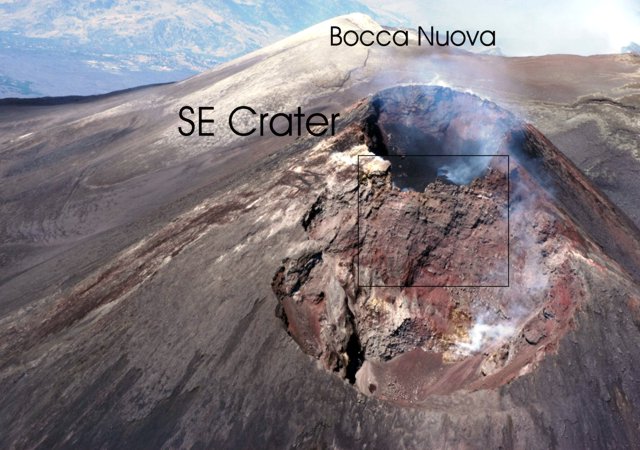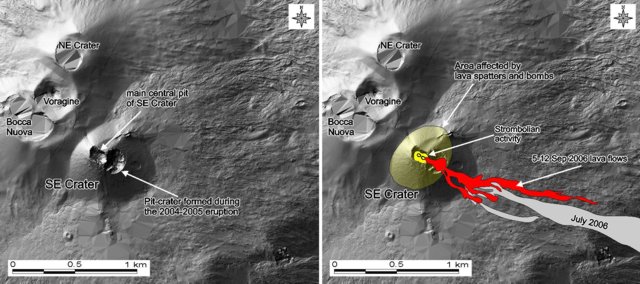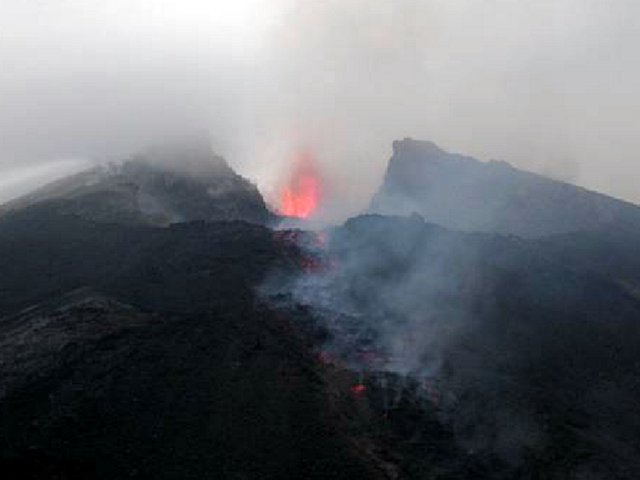Report on Etna (Italy) — August 2006
Bulletin of the Global Volcanism Network, vol. 31, no. 8 (August 2006)
Managing Editor: Richard Wunderman.
Etna (Italy) Changes in morphology of SE Crater and the emission of lava flows to the SSE
Please cite this report as:
Global Volcanism Program, 2006. Report on Etna (Italy) (Wunderman, R., ed.). Bulletin of the Global Volcanism Network, 31:8. Smithsonian Institution. https://doi.org/10.5479/si.GVP.BGVN200608-211060
Etna
Italy
37.748°N, 14.999°E; summit elev. 3357 m
All times are local (unless otherwise noted)
Strombolian eruptions, which had resumed in late August 2006, continued into September and took place in conjunction with lava flows escaping towards the ESE and reaching over 1 km in length by mid-September. A large circular depression had grown along the SE side of the cone at Southeast Crater (SEC) during 2004-5. The wall between the depression and the SEC's established central crater became increasingly eroded. On 10 September 2006 that weak zone failed. Lava erupted in the SEC's central crater soon filled the depression and then moved SSE.
The following report was supplied by Sonia Calvari and other members of the Istituto Nazionale di Geofisica e Vulcanologia (INGV). The INGV website featured several reports on this time interval (including Lodato and Consoli, 2006; and Neri and others, 2006).
After the short eruptive phase of 14-24 July 2006 (BGVN 31:07) and the renewal of explosive activity at the Northeast Crater at the end of July, Strombolian activity resumed at SEC's summit in the early morning of 31 August. This activity was mild, with fallout of lapilli and bombs mainly within the crater. The ejecta eventually filled the SEC, and between 1900 and 2000 on 5 September an overflow from the summit formed spectacular lava falls along the breached E side. The descending lava accumulated within the prominent circular depression (figure 112) on the SEC's eastern flank.
Figure 113 presents plan views of Etna's SEC and vicinity, indicating the large depression that grew on the cone's SE side. The scene during July 2006 (left panel) provides a size comparison between the SEC's established central crater and the recent depression immediately to its SE. The 12 September 2006 scene (figure 113, right) shows the lava's eventual path. After lava flows escaped the central crater, they ponded in the adjacent depression. They later crossed the rim of the depression, and went on to advance over 1 km E.
The overflow from the SEC's central crater that began on 5 September continued to spread within the depression until about 0645 on 7 September, when it overflowed the SEC's eastern rim and started to spread on the outer E flank and from there towards the Valle del Bove rim. The flow was extremely viscous, slow, thin, and cold, mainly propagating through collapses and breaching of the `a`a flow front. Explosive activity continued at the SEC summit with variable intensity and lava blocks falling as far down as the base of the SEC's cone.
The failure of the SEC's upper wall (figure 112) took place late in the evening of 10 September, due to the pressure of magma accumulating within the summit crater. A new rock fall occurred at the wall dividing the SEC summit crater from the eastern depression, and was suddenly covered by the lava flow spilling from the summit crater. An ash plume rose from the failed material and blew W. No significant ash fallout was observed on the ground, but a lava flow spread E, advancing slowly towards the Valle del Bove rim. After the wall had fallen Strombolian emissions continued at the SEC (figure 114).
On 12 September the lava-flow length reached ~1.5 km E of the vent at SEC's crater. Both lava effusion and explosive Strombolian activity continued until 27 September, when both stopped following a sudden decrease in volcanic tremor.
References. Neri, M., Behncke, B., and Norini, G., 12 September 2006, Forma e strutture del Cratere Sud-Est (Etna) tra l'eruzione di luglio 2006 e l'attivit? eruttiva in corso, aggiornata al 12 settembre 2006 ['Forms and structures of the SEC from the eruption of July 2006 and ongoing eruptive activity, updated 12 September 2006']: Prot. int., WKRVGFTR20060913.pdf [UFVG2006/107].
Lodato, L., and Consoli, O., 11 September 2006, Aggiornamento attivit? Etna ['Etna activity update']: INGV, Catania, U.F. Vulcanologia e Geochimica, 20060911.pdf [UFVG2006/107].
Geological Summary. Mount Etna, towering above Catania on the island of Sicily, has one of the world's longest documented records of volcanism, dating back to 1500 BCE. Historical lava flows of basaltic composition cover much of the surface of this massive volcano, whose edifice is the highest and most voluminous in Italy. The Mongibello stratovolcano, truncated by several small calderas, was constructed during the late Pleistocene and Holocene over an older shield volcano. The most prominent morphological feature of Etna is the Valle del Bove, a 5 x 10 km caldera open to the east. Two styles of eruptive activity typically occur, sometimes simultaneously. Persistent explosive eruptions, sometimes with minor lava emissions, take place from one or more summit craters. Flank vents, typically with higher effusion rates, are less frequently active and originate from fissures that open progressively downward from near the summit (usually accompanied by Strombolian eruptions at the upper end). Cinder cones are commonly constructed over the vents of lower-flank lava flows. Lava flows extend to the foot of the volcano on all sides and have reached the sea over a broad area on the SE flank.
Information Contacts: Sonia Calvari, Marco Neri, Luigi Lodato, Boris Behncke, Gianluca Norini, and Orazio Consoli, Istituto Nazionale di Geofisica e Vulcanologia (INGV), Sezione di Catania, Piazza Roma 2, 95123 Catania, Italy.




